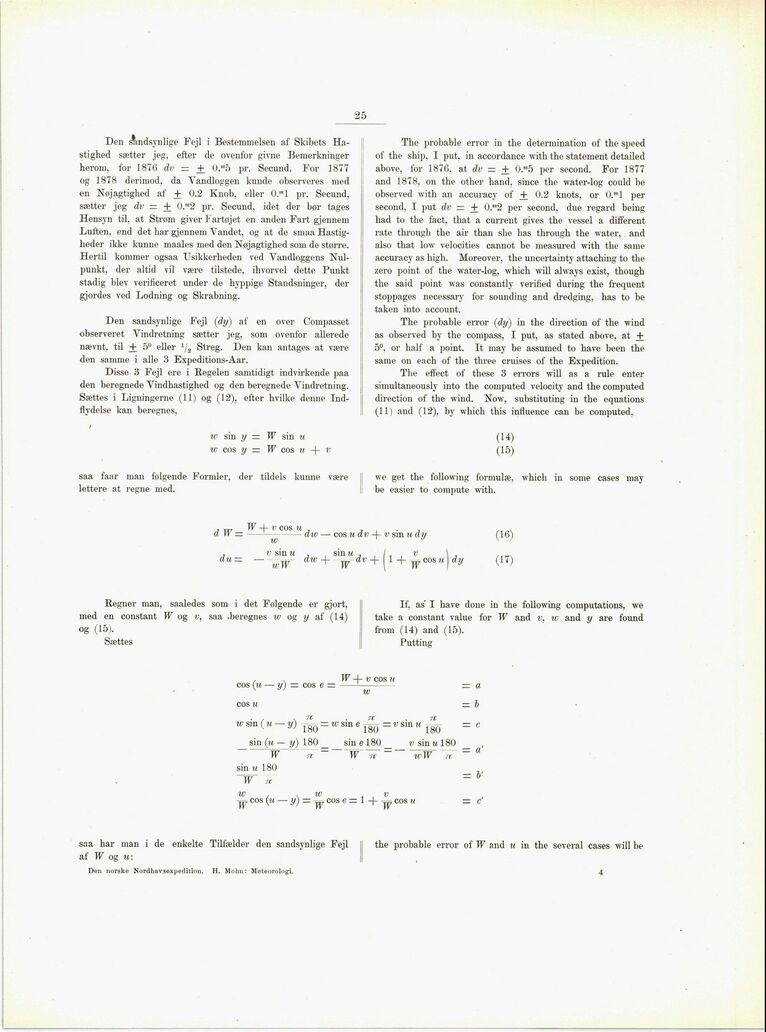
Full resolution (JPEG) - On this page / på denna sida - Sidor ...

<< prev. page << föreg. sida << >> nästa sida >> next page >>
Below is the raw OCR text
from the above scanned image.
Do you see an error? Proofread the page now!
Här nedan syns maskintolkade texten från faksimilbilden ovan.
Ser du något fel? Korrekturläs sidan nu!
This page has never been proofread. / Denna sida har aldrig korrekturlästs.
25
Den ^tndsynlige Fejl i Bestemmelsen af Skibets
Hastighed sætter jeg. efter de ovenfor givne Bemerkninger
herom, for 1876 dv = + 0.m5 pr. Secund. For 1877
og 1878 derimod, da Vandloggen kunde observeres med
en Nøjagtighed af + 0.2 Knob, eller 0.ml pr. Secund,
sætter jeg dv = + 0.m2 pr. Secund, idet der bør tages
Hensyn til, at Strøm giver Fartøjet en anden Fart gjennem
Luften, end det har gjennem Vandet, og at de smaa
Hastigheder ikke kunne maales med den Nøjagtighed som de større.
Hertil kommer ogsaa Usikkerheden ved Vandloggens
Nulpunkt, der altid vil være tilstede, ihvorvel dette Punkt
stadig blev verificeret under de hyppige Standsninger, der
gjordes ved Lodning og Skrabning.
Den sandsynlige Fejl (dy) af en over Compasset
observeret Vindretning sætter jeg, som ovenfor allerede
nævnt, til + 5° eller 1/2 Streg. Den kan antages at være
den samme i alle 3 Expeditions-Aar.
Disse 3 Fejl ere i Regelen samtidigt indvirkende paa
den beregnede Vindhastighed og den beregnede Vindretning.
Sættes i Ligningerne (11) og (12), efter hvilke denne
Indflydelse kan beregnes,
The probable error in the determination of the speed
of the ship, I put, in accordance with the statement detailed
above, for 1876, at dv = + 0.m5 per second. For 1877
and 1878, on the other hand, since the water-log could be
observed with an accuracy of + 0.2 knots, or 0.ml per
second, I put dv z- + 0.m2 per second, due regard being
had to the fact, that a current gives the vessel a different
rate through the air than slie has through the water, and
also that low velocities cannot be measured with the same
accuracy as high. Moreover, the uncertainty attaching to the
zero point of the water-log, which will always exist, though
the said point was constantly verified during the frequent
stoppages necessary for sounding and dredging, has to be
taken into account.
The probable error (dy) in the direction of the wind
as observed by the compass, I put, as stated above, at +
5°, or half a point. It may be assumed to have been the
same on each of the three cruises of the Expedition.
The effect of these 3 errors will as a rule enter
simultaneously into the computed velocity and the computed
direction of the wind. Now, substituting in the equations
(11) and (12), by which this influence can be computed,
w sin y — W sin u
w eos y — W eos u + v
(14)
(15)
saa faar man følgende Formler, der tildels kunne være
lettere at regne med.
we get the following formulæ, which in some cases may
be easier to compute with.
W -f v eos u , , . ,
d W ■=–- - dw — eos udv v sin u dy
du= –-
w
(16)
(17)
Regner man, saaledes som i det Følgende er gjort,
med en constant W og v, saa .beregnes w og y af (14)
og (15).
Sættes
If, as" I have done in the following computations, we
take a constant value for W and v, w and y are found
from (14) and (15).
Putting
, . W + v eos u
eos (u — y) — eos e ~-—––––=: a
eos u — b
w sin (w — y) ^ = w sin e ~ = v sin u ^ = c
sin (w — ü/)180_ sin e 180 v sin u 180
W
sin u 180
~W~ 7t
W
uW
W
r \ w i i u
eos (■u — y) — yy eos e ■=. 1 + ^ eos u
W
= a
= b’
saa har man i de enkelte Tilfælder den sandsynlige Fejl
af W og w:
Den norske Nordhavsexpedition. H. Mohn: Meteorologi.
the probable error of W and u in the several cases will be
<< prev. page << föreg. sida << >> nästa sida >> next page >>